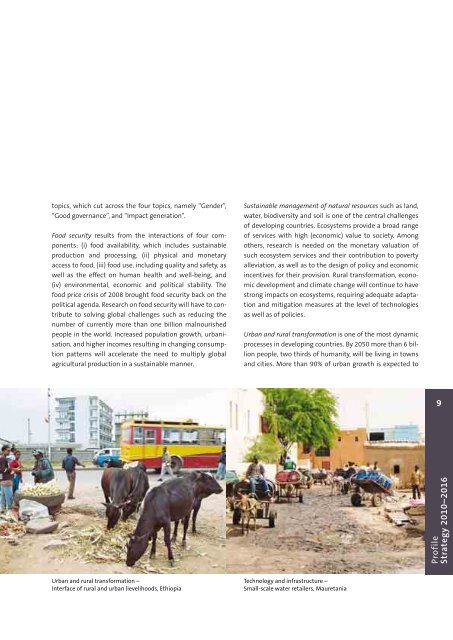NORTH-SOUTH CENTRE - ETH - North-South Centre North-South ...
NORTH-SOUTH CENTRE - ETH - North-South Centre North-South ...
NORTH-SOUTH CENTRE - ETH - North-South Centre North-South ...
Create successful ePaper yourself
Turn your PDF publications into a flip-book with our unique Google optimized e-Paper software.
topics, which cut across the four topics, namely “Gender”,<br />
“Good governance”, and “Impact generation”.<br />
Food security results from the interactions of four components:<br />
(i) food availability, which includes sustainable<br />
production and processing, (ii) physical and monetary<br />
access to food, (iii) food use, including quality and safety, as<br />
well as the effect on human health and well-being, and<br />
(iv) environmental, economic and political stability. The<br />
food price crisis of 2008 brought food security back on the<br />
political agenda. Research on food security will have to contribute<br />
to solving global challenges such as reducing the<br />
number of currently more than one billion malnourished<br />
people in the world. Increased population growth, urbanisation,<br />
and higher incomes resulting in changing consumption<br />
patterns will accelerate the need to multiply global<br />
agricultural production in a sustainable manner.<br />
Sustainable management of natural resources such as land,<br />
water, biodiversity and soil is one of the central challenges<br />
of developing countries. Ecosystems provide a broad range<br />
of services with high (economic) value to society. Among<br />
others, research is needed on the monetary valuation of<br />
such ecosystem services and their contribution to poverty<br />
alleviation, as well as to the design of policy and economic<br />
incentives for their provision. Rural transformation, economic<br />
development and climate change will continue to have<br />
strong impacts on ecosystems, requiring adequate adaptation<br />
and mitigation measures at the level of technologies<br />
as well as of policies.<br />
Urban and rural transformation is one of the most dynamic<br />
processes in developing countries. By 2050 more than 6 billion<br />
people, two thirds of humanity, will be living in towns<br />
and cities. More than 90% of urban growth is expected to<br />
9<br />
Profile<br />
Strategy 2010–2016<br />
Urban and rural transformation –<br />
Interface of rural and urban lievelihoods, Ethiopia<br />
Technology and infrastructure –<br />
Small-scale water retailers, Mauretania
















